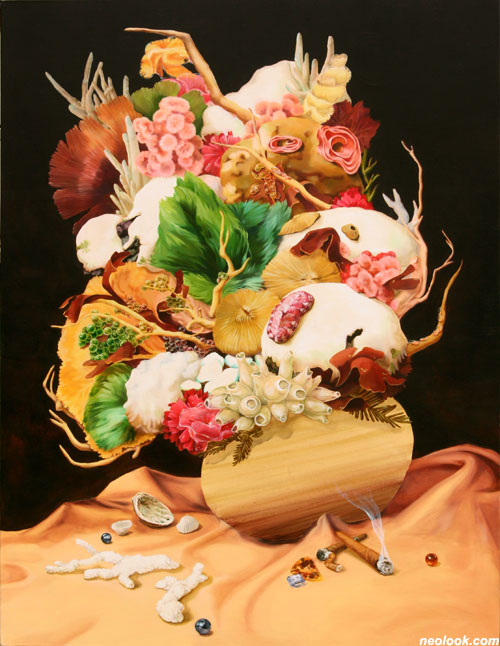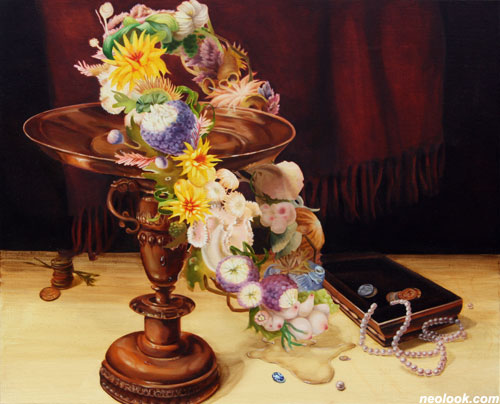- ● homepage
- ● archives
- ● restoration
- ● books
- ● big banners
- ● post board
- ■ neo's search
- ■ about us
- ■ 게재방법 안내
- 개인정보처리방침

- [email protected]
- Tel. 02_335_7922
- Fax. 02_335_7929
- 10:00am~04:30pm
- 월요일~금요일
- 3/3(월) 대체공휴일

Sub Rosa - 비밀
엄해조展 / HAEJO / 嚴海祚 / painting 2013_0604 ▶ 2012_0705 / 일,공휴일 휴관
● 위 이미지를 클릭하면 엄해조 인스타그램으로 갑니다.
엄해조 유튜브_https://www.youtube.com/@amazeoh
초대일시 / 2013_0605_수요일_06:30pm
2013 안국약품 신진작가공모展
주최 / 안국약품(주)
관람시간 / 10:00am~06:00pm / 일,공휴일 휴관
갤러리 AG GALLERY AG 서울 영등포구 대림동 993-75번지 안국약품 1층 Tel. +82.2.3289.4399 www.galleryag.co.kr
또 하나의 '바니타스 정물화' ● 엄해조는 '정물화'를 줄곧 그려왔다. 그러나 보통의 정물화와는 정감이 사뭇 다르다. 아름답게 활짝 핀 꽃이나 탐스럽게 잘 익은 과일 같은 소재는 결코 찾을 수가 없다. 꽃병이나 탁자, 검은 벽면, 무대장치 같은 상황 설정이 정물화임을 암시하고 있지만, 실상 화면의 많은 부분은 도무지 정체를 알 수 없는 기이한 풍경으로 가득 차 있다. 선뜻 정물화로 받아들이기가 쉽지 않다. 작품의 형상들을 하나하나 뜯어보자. 구불구불한 나무줄기 같기도 하고, 식물의 이파리 같기도 하며, 채소나 과일의 어느 한 부분을 잘라 놓은 듯 보이기도 한다. 그 형상들이 화면에 서로 뒤엉켜 빼곡히 들어 서 있다. 그 어느 형상 하나라도 온전한 것이라고 할 수 없다. 막 생성 중인 형상이자, 바로 소멸 중인 형상이다. 물컹물컹하고 흐물흐물한 액체 느낌이 있는가 하면, 딱딱하게 굳어버린 고체 같은 느낌도 있다. 때로는 초현실주의자들이 즐겨 그렸던 아메바 같은 형태가 연상된다. 꿈속에서나 만났던 산수, 그 희미한 기억에 비유할 수 있을까. 내시경으로 동물의 내장을 들여다보면, 이런 야릇한 광경을 대할 수 있을까. 혹 지구 밖의 다른 행성에서나 존재할 법한 풍경이랄까.

- 엄해조_Quid videtis?Ⅰ_캔버스에 유채_145.5×112cm_2013

- 엄해조_Vanitas2 _캔버스에 유채_72.7×60.6cm_2009

- 엄해조_Ignis non ExtinguiⅡ_캔버스에 유채_63.6×90cm_2012
엄해조의 작품 소재는 '바다 생물'이다. 바로 여기에 작품의 비밀이 숨어 있다. 작가는 바다에서 자라는 식물과 동물을 그린다. 그러니까 꽃을 대신해 바다 생물을 병에 꽂은 설정인 것이다. 애초에 작가는 실제 바다 생물과 그것을 닮게 만든 가짜 모형을 꽃꽂이하듯 병에 가득 꽂아, 시간의 경과에 따라 변화 과정을 촬영하고, 여기에다 가상의 디지털 이미지를 합성해 사진 작품을 제작했다. '진짜, 가짜, 가상'의 세 가지 차원 중 진짜 바다생물만 짧은 시간에 생명을 다하고 사라지는 과정을 생생하게 기록해 본 것이다. 그 이후, 엄해조는 사진 도감을 참조해 바다 생물을 그리는 회화 작업을 지속하고 있다. 불가사리, 산호꽃, 말미잘, 갯고사리, 조개, 성게, 해초, 알…. 바다 생물이 육지에 상륙해 순식간에 '죽음'에 이르는 과정, 작가는 그 찰나를 끈질기게 붙잡는다. 일견 도원경(桃園境) 혹은 아르카디아처럼 보이는 엄해조의 작품에는 바니타스(Vanitas)의 메시지가 깔려 있다.(바니타스란 라틴어로 '인생무상'이란 뜻이다.) ● 엄해조는 바니타스 정물화를 그린다. 일찍이 대(大) 얀 브뤼겔이나 아드리안 판 위트레흐트, 암브로시우스 보스하르트 같은 16, 17세기 프랑드르 화가들의 정물화에 깊이 매료되어, 이 미술사의 고전 작품을 자신의 작품에 적극 '참조'해 왔다. 포스트모던 미술에서 성행하는 인용(Appropriation)의 방법론이라고 할 수 있지만, 그렇다고 작품을 통해 미술사적 비판이나 알레고리 수법을 구사하는 것은 아니다. 오히려 바니타스 정물화에 대한 오마주, 엄해조 식의 조형적 '번안'이라고 하는 것이 옳다. 말하자면 바니타스의 전통을 따르면서도 좀더 적극적인 자기식의 조형 변주에 치중하는 정물화인 것이다.

- 엄해조_Ignis non ExtinguiⅢ_캔버스에 유채_63.6×90cm_2013

- 엄해조_Ignis non ExtinguiⅠ_캔버스에 유채_63.6×90cm_2012
엄해조는 바니타스 정물화에 '찰나의 표현'을 적극 동원한다. 미술사에서 바니타스 정물화는 이 세상의 삶이 일시적이고 부질없음을 노래한다. 바로크 시대에 특히 성행했던 바니타스 정물화에는 죽음을 연상시키는 상징적인 소도구들이 단골로 등장한다. 짧고 덧없는 세속의 삶을 상징하는 소재로는 해골(두개골), 시들어 떨어져 있는 꽃잎, 깨지기 쉬운 유리잔, 깃털 달린 펜, 연기가 피어오르는 촛불 등이 있다. 엄해조 역시 이러한 소재를 적극 끌어들이면서 커튼에 가린 시계, 엎질러진 물, 탁자 모서리에서 막 떨어질 것 같은 유리잔, 퍼덕거리는 생선, 기울어져 뒤뚱거리는 병 등으로 자신만의 정물화를 펼쳐낸다. 특히 정물화는 배열의 미적 효과, 요컨대 '구성의 묘'가 작품의 성격을 좌우하는 경우가 많다. 그래서 엄해조 특유의 조형 어휘들의 매력을 찾아내는 것도 큰 즐거움이다. 수채화처럼 투명하고 경쾌한 마티에르, 속도감 있게 흘러내리거나 질주하는 붓 자국, 살아 있는 유기체처럼 번식해 가는 구성 인자들…, 그 자체로 꿈틀거리는 생명체로 우뚝 서 있다. 생명이 찬란하게 빛나면 빛날수록 죽음의 바니타스는 더 어둡고 지독하리라. ● 엄해조는 왜 바니타스를 그리는가. 죽음과 허무의 주제가 과연 이 젊은 작가에게는 어떤 의미로 작용하는 걸까. 일찍이 바로크 시대에 바니타스 정물화가 성행했던 것은 묵시록처럼 죽음이 일상화되던 시대를 거쳐 사람들이 죽음을 객관화할 수 있게 된 세상의 변화와 맞물려 있었다. 죽음을 조용히 관조하고, 무(無)로 돌아갈 수밖에 없는 삶을 인정하는 태도로 바뀐 것이다. 여기에서, 이른바 메멘토 모리(Memento mori, 죽음을 기억하라)의 경구가 등장한다. 메멘토 모리는 인간을 죽음의 공포로 내몰아치는 것이 아니라 짧은 인생을 충실히 보낼 것을 가르치는 잠언인 것이다. 엄해조의 바니타스 정물화에도 삶을 바라보는 한 젊은 화가의 경건한 시선이 깔려 있다. 메멘토 모리. 죽음을 되짚는 일은 삶을 되짚는 일이 아닌가. 죽음이 있기에, 소중한 삶이…. ■ 김복기

- 엄해조_Desire with time, Time flowing life_람다 프린트, 디아섹_각 235×45.75cm_2010
Not Just Another Vanitas Still Life ● Eom Haejo has always painted 'still life' paintings. Eom's still lifes, however, aren't like any ordinary one: you won't be able to find flowers in full bloom, or enticingly ripe fruits—objects commonly found in still life paintings. The vase, the dark backdrop, and the staged settings of different objects suggest that they are still life paintings. But still, the viewers won't be able to willingly accept them as still lifes, not until they take a step closer to observe the details. Some objects look like crooked tree boughs, and others look like botanical foliages. Some even look like as if someone had cut across a fruit. All of these elements are scattered—at the artist's intent—across the canvas, densely filling up the pictorial plane. Not a single subject matter confidently posits its wholeness: they are shapes in the process of creation, and concurrently in the process of extinction. They are mushy and fluidic, solid and firm. Sometimes, they resemble amoeba-like forms the surrealists often incorporated. Could they be a dim reminiscence of a landscape that we may have witnessed in our dreams? Or are they something that we can only see by endoscopy of our intestines? Or, they could be, something that we might be able to encounter on some other planets. ● The answers to these questions become simple when we realize that Eom's main subject matters are marine organisms. The secrets to her works are here: she paints the plants and animals of the sea, instead of flowers or fruits. In the beginning of her vanitas series, Eom collected and set up the actual specimens in a vase, and photographed the set model as they transformed their shapes and character with the elapse of time. She then produced a series of images, digitally adding some imaginary objects. This photographic work is her documentary of the progression of life to death, an evidence of the three different phases in our dimension: the real, the false, and the imaginary. Moving on, Eom brought this idea of life and death into her forte—painting—using pictures and photos of marine objects: starfishes, coral reefs, sea anemone, feather stars, shellfish, sea urchins, sea grass, fish eggs, etc…. Eom ceaselessly pursues the precise moment of the marine organisms reaching their deaths, soon after they are on land. Her works, in some instances described as depictions of the Shangri-la, or the ancient Arcadia, are filled with implications of futility, or (in Latin) Vanitas. ● Eom describes that her first inspiration came after being captivated by the works of the Dutch masters--Jan Brueghel the Elder, Adriaen van Utrecht, Ambrosius Bosschaert, etc.—of the late 16th to early 17th century. During her college, she relentlessly referred to their works to create her paintings. One might say that she is "appropriating" their works, a technique popularly utilized by the (and still) Postmodernists; however, unlike postmodernism, Eom doesn't attempt to provide allegorical methods nor is trying to criticize any art historical discourses. Instead, it may be more accurate to state that they are her homages to vanitas, or, her own way of aesthetical "adaptation". In other words, while Eom follows all the rules of painting a vanitas still life, but she actively and unhesitantly incorporates unique variations to make them her own. ● Eom assiduously utilizes the 'expression of the precise moment' in her works. In the arts, vanitas still life paintings recite the futility of life, death and its inevitability. Popular during the Baroque era, vanitas still lifes consist of elements that symbolize death: a skull, symbolizing the short and futile life; withered flower petals, the fall of all things; fragile glassware, frailty of men; a quill pen, blown out candles, etc. The artist successfully incorporates these basic elements with her own symbols: partially hidden clock, spilt water, glassware on the edge of the table, flapping fish, wobbling bottle, etc. It's often crucial for still life paintings to maintain principles of arrangement, or, the "beauty of composition". And this is why it's also interesting to explore the uniqueness of the visual language hidden in Eom's works: the cheerful and clear, watercolor-like matière; the speedy, dashing brushstrokes; composite particles, seemingly proliferating within the pictorial plane… they come to life, on their own, as beings. The brighter the life, the darker and more severe the death that vanitas implies. ● Still, some may wonder why Eom paints the vanitas. Why has death and futility become an attachment, and moreover, what does it mean to her? One reason why vanitas became popular during the Baroque era is because the people have grown to objectify death, as their daily life was close to the description of the Apocalypse. They silently contemplated death, and understood the life as returning to nought. At this point, the saying Memento mori (Latin 'remember that you will die') appeared; a proverb that reminds us to live our short lives to the fullest—because of our mortality—rather than force us into the terror of death. In Eom's vanitas, there is a revering gaze on life of this young artist. The Memento mori: to remind ourselves of death is to remind we are alive. Life is precious, because of death…. ■ Boggi Kim
Vol.20130607e | 엄해조展 / HAEJO / 嚴海祚 / painting

